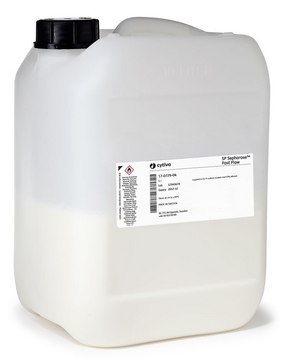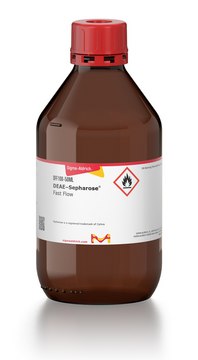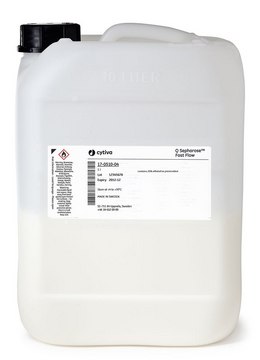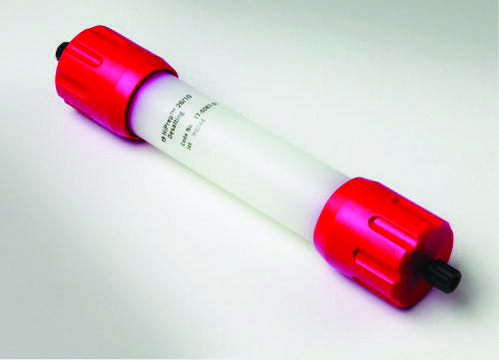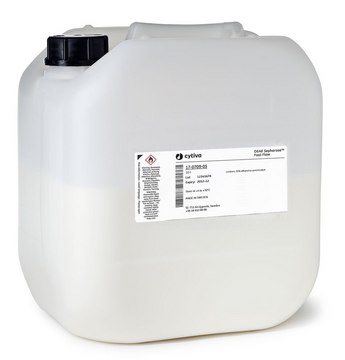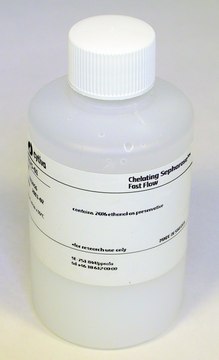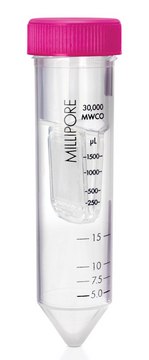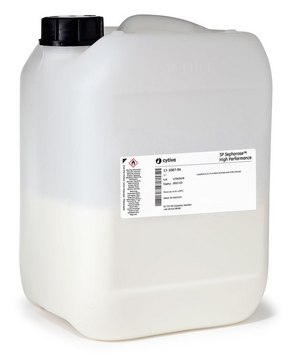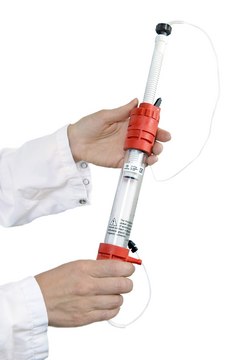GE17-0729-01
SP Sepharose™ Fast Flow
Cytiva 17-0729-01, pack of 300 mL
Synonym(s):
SP Sepharose, Sepharose Fast Flow Column
About This Item
Recommended Products
ligand
sulphopropyl
description
Ion Exchanger Type (value)
packaging
pack of 300 mL
manufacturer/tradename
Cytiva 17-0729-01
matrix
6% cross-linked agarose
particle size
45-165 μm
average diameter
90 μm
cleaning in place
3-14
working range
4-13
capacity
70 mg binding capacity(ribonuclease A/ml medium)
suitability
suitable for bioprocess medium
General description
SP Sepharose™ Fast Flow is part of the Sepharose™ Fast Flow ion exchange platform, which has been the industrial standard for ion exchange chromatography during recent decades. It is composed of crosslinked 6% agarose beads, with sulphopropyl (Q) strong cation exchange groups. SP Sepharose™ Fast Flow has high chemical stability, allowing well proven cleaning-in-place (CIP) and sanitization protocols. Scale-up with SP Sepharose™ Fast Flow is straight forward and the medium is available in a range of pre-packed process development tools.
As member of the BioProcess media range, SP Sepharose™ Fast Flow meets industrial demands with security of supply and comprehensive technical and regulatory support.
Features and Benefits
- Well-proven strong cation exchanger developed for industrial downstream processes.
- Used extensively for capture and intermediate purification of a wide range of approved biopharmaceuticals
- The industry standard for ion exchange chromatography during recent decades
- High chemical stability allows for well proven CIP and sanitization protocols
- The hydrophilic nature of the base matrix ensures low levels of non-specific binding leading to low levels of host cell-derived impurities in the elution pool.
Storage and Stability
Analysis Note
Legal Information
Signal Word
Warning
Hazard Statements
Precautionary Statements
Storage Class Code
3 - Flammable liquids
Regulatory Information
Choose from one of the most recent versions:
Certificates of Analysis (COA)
Sorry, we don't have COAs for this product available online at this time.
If you need assistance, please contact Customer Support.
Already Own This Product?
Find documentation for the products that you have recently purchased in the Document Library.
Articles
Capto MMC is a multimodal cation exchanger with the properties of a weak cation exchanger. In addition to electrostatic interactions, the ligand structure provides for additional interaction modes such as hydrophobic interaction, hydrogen bonding, and thiophilic interaction.
This page describes principles and standard conditions for different purification techniques of histidine-tagged proteins using Cytiva products.
This page covers the standard ÄKTAdesign configurations for simple IEX chromatography.
This page shows volatile and non-volatile buffer suggestions for anion and cation exchange chromatography.
Protocols
This page covers the use of Sepharose Fast Flow for purification of proteins.
This page shows how to perform column packing and preparation for ion exchange chromatography and chromatafocusing when using Tricorn or XK columns available from Cytiva.
This page clarifies sample preparation, buffer exchange and desalting, removal of lipoproteins, phenol red, and low molecular weight contaminants in Ion exchange chromatography.
This page covers detailed information on cleaning procedures and recommended flow for column cleaning.
Our team of scientists has experience in all areas of research including Life Science, Material Science, Chemical Synthesis, Chromatography, Analytical and many others.
Contact Technical Service
